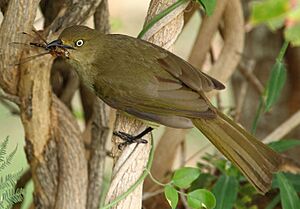Sombre greenbul facts for kids
Quick facts for kids Sombre greenbul |
|
|---|---|
 |
|
| A. i. oleaginus at uMkhuze Game Reserve, KwaZulu-Natal, South Africa | |
| Conservation status | |
| Scientific classification | |
| Genus: |
Andropadus
|
| Species: |
importunus
|
 |
|
| resident range | |
| Synonyms | |
|
|
The sombre greenbul (scientific name: Andropadus importunus) is a type of bird that belongs to the bulbul family. These birds live in eastern and southern Africa. You can find them in places like coastal bushes, evergreen forests, and dry shrub lands. The sombre greenbul is special because it is the only bird left in its group, called the Andropadus genus.
Contents
Understanding the Sombre Greenbul's Family Tree
Birds are grouped into families and genera, much like how your own family has different branches. The sombre greenbul's scientific name is Andropadus importunus. It's the only species in the Andropadus group.
How Scientists Classify Greenbuls
Originally, there were 18 different types of greenbuls in the Andropadus group. But in 2010, scientists re-sorted many of them into new groups. These new groups are called Arizelocichla, Stelgidillas, and Eurillas. After this change, the sombre greenbul was the only one left in the Andropadus group.
The sombre greenbul was first described as part of the Turdus group. Later, it was moved to the Andropadus group. Some experts also call it by other names, like the sombre bulbul or the southern sombre greenbul.
Different Types of Sombre Greenbuls
There are four main types, or subspecies, of the sombre greenbul. They live in different parts of Africa:
- Zanzibar sombre greenbul (A. i. insularis): This type lives from southern Ethiopia and Somalia down to eastern Tanzania.
- Transvaal sombre greenbul (A. i. importunus): You can find this one in the highlands of northern South Africa and western Eswatini. It also lives along the coast down to the Western Cape.
- Endoto sombre greenbul (A. i. oleaginus): This type is found in southern Zimbabwe, southern Mozambique, and the lowlands of northern South Africa.
- A. i. hypoxanthus: This subspecies lives in south-eastern Tanzania, central Mozambique, central Zimbabwe, and south-central Zambia.
What Does the Sombre Greenbul Look Like?
The sombre greenbul is about 15 to 18 centimeters (6 to 7 inches) long. Its feathers are mostly a dull grayish olive-green color. The feathers on its belly are lighter than those on its back.
The bird's color can change depending on where it lives. Birds in southern Africa are usually plain olive-green. Those further north might be yellower with greener upper parts. A cool feature of this bird is its white eyes!
Male and female sombre greenbuls look very similar. Young birds are even duller in color than adults and have dark, grey eyes. The A. i. hypoxanthus subspecies is much yellower on its underside than the other types.
What Sounds Does It Make?
The sombre greenbul is a very noisy bird! You'll often hear it before you see it. Its most common call is a long, ringing sound. It starts with a clear whistle, like weeeewee. Then it makes a jumbled, gurgling sound. It finishes with a sad, drawn-out whistle, like willy. If the bird is upset or worried, it might make a repeated peeet peeet peeet sound.
Sombre Greenbul Behavior and Habitat
The sombre greenbul is a common bird, but it likes to stay hidden in thick leaves. This is why you often hear its calls more than you see the bird itself.
These birds usually live in pairs or small groups. They spend their time looking for food. Their diet includes insects, fruits, and small snails. They are an important part of the ecosystem in their African habitats.



